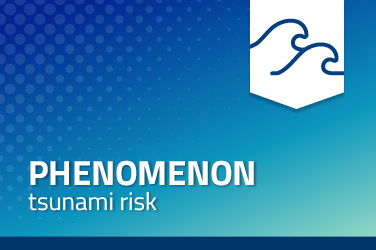Tsunami risk. The phenomenon

A seaquake, or tsunami in Japanese, is a series of ocean waves generated by the rapid movement of a large mass of water. In the open sea, the waves propagate quickly over large distances with almost imperceptible heights (even less than one meter) but with wavelengths (distance between one wave and the next) that can reach some tens of kilometers. As the waves approach the coast, their speed decreases, and their height increases rapidly, even by tens of meters.
The tsunami waves can be distinguished from ordinary ocean waves by certain characteristics. The common sea waves produced by the wind, move only the most superficial part of the water, not causing any movement in depth. The tsunami waves, instead, move the entire water column, from the bottom to the surface. For this reason, unlike other wave , they have a strong energy capable of pushing them at high speed for several hundred meters inland and their impact on the coast, therefore, is much stronger.
The tsunami wave may look like a wall of water that hits the coast causing a flood, or as a rapid rise in sea level , similar to a tide that is growing rapidly. Sometimes the wave may be preceded by an unusual and temporary withdrawal of water (even several meters), which leaves dry ports and coasts.
The first wave may not be the biggest and between the arrival of a wave and the next it can take several minutes. A tsunami wave in open water is less than a meter high turns, when it arrives on the coast, in a wall of water that can exceed 30 meters. The propagation speed of a tsunami wave depends on the depth of the bottom : the greater the depth , the greater the speed of the waves. In very deep water ( over 4,000 meters ) waves can exceed 700 km/h. Arriving near the coast, the wave is always shallower depths and therefore its speed decreases dramatically. This is due to the fact that the energy flow of the tidal wave, which depends both on the speed that the height of the wave, remains constant. Consequently , when the speed of the tidal wave decreases, its height grows. That's why tsunami waves aren’t noticeable off the coasts but become devastating when reaching several meters in height.
The causes of the tsunami. A tsunami is born from the sudden displacement of a large mass of water, caused by strong earthquakes with epicenter in the sea or near the coast, from coastal or submarine landslides, volcanic activity in the sea or near the coast and, much more rarely, from meteorites falling into the sea. Its energy, and thus its hazard, depend on the size of the phenomenon that caused it.
A tsunami can be generated by an undersea earthquake if it:
• is very strong, generally with magnitudes greater than 6.5 ;
• has a hypocenter (depth in areas where there is the breaking of rocks giving rise to the earthquake ) not too deep ;
• produces a vertical displacement of the seafloor.
When there is a strong undersea earthquake a part of the seabed rises abruptly with a vertical displacement. The mass of water above loses its balance and is set in motion, so that the surface will form one or more waves that, even if only a few tens of centimeters high, have a large wavelength (distance between one wave and the next).
Tsunamis generated by landslides (both undersea and above the sea level with material falling into the sea) have less energy than those generated by earthquakes. Their strength is exhausted more quickly, and the waves can’t get very far; however, these tsunamis can produce very high waves and be destructive in areas close to where the landslide was generated.
The tsunamis generated by volcanic activity, at sea or near the coast, are less frequent than those produced by underwater earthquakes , but can still be very strong. Violent submarine eruptions can cause the movement of large volumes of water and generate dangerous tsunamis. Tsunamis of volcanic origin are mainly caused by explosive eruptions . This happens when the vent of the submarine volcano is located near the surface of the water . Sub-aerial eruptions of volcanoes , located near the coast (such as Stromboli) , can produce dense clouds of gas and lava fragments which, gliding at high speed along the slopes of the volcano and falling into the sea , move large volumes of water generating tsunami waves . In the case of particularly violent eruptions, the volcano may collapse completely or partially forming a caldera, or what remains of a volcanic building following the collapse of the magma chamber. If this happens on a volcanic island a tidal wave may occur.